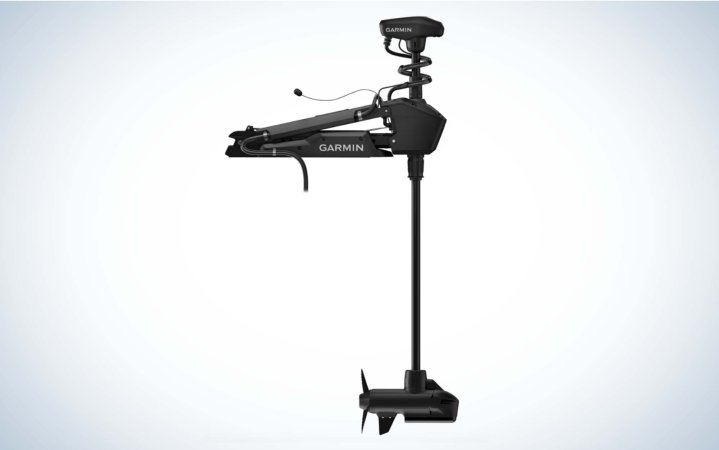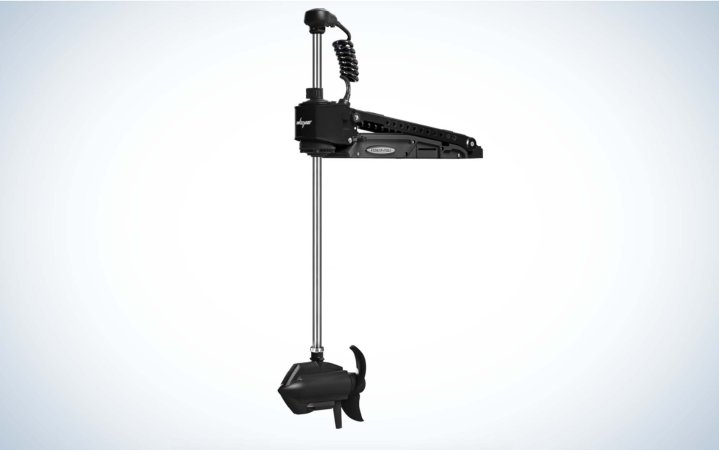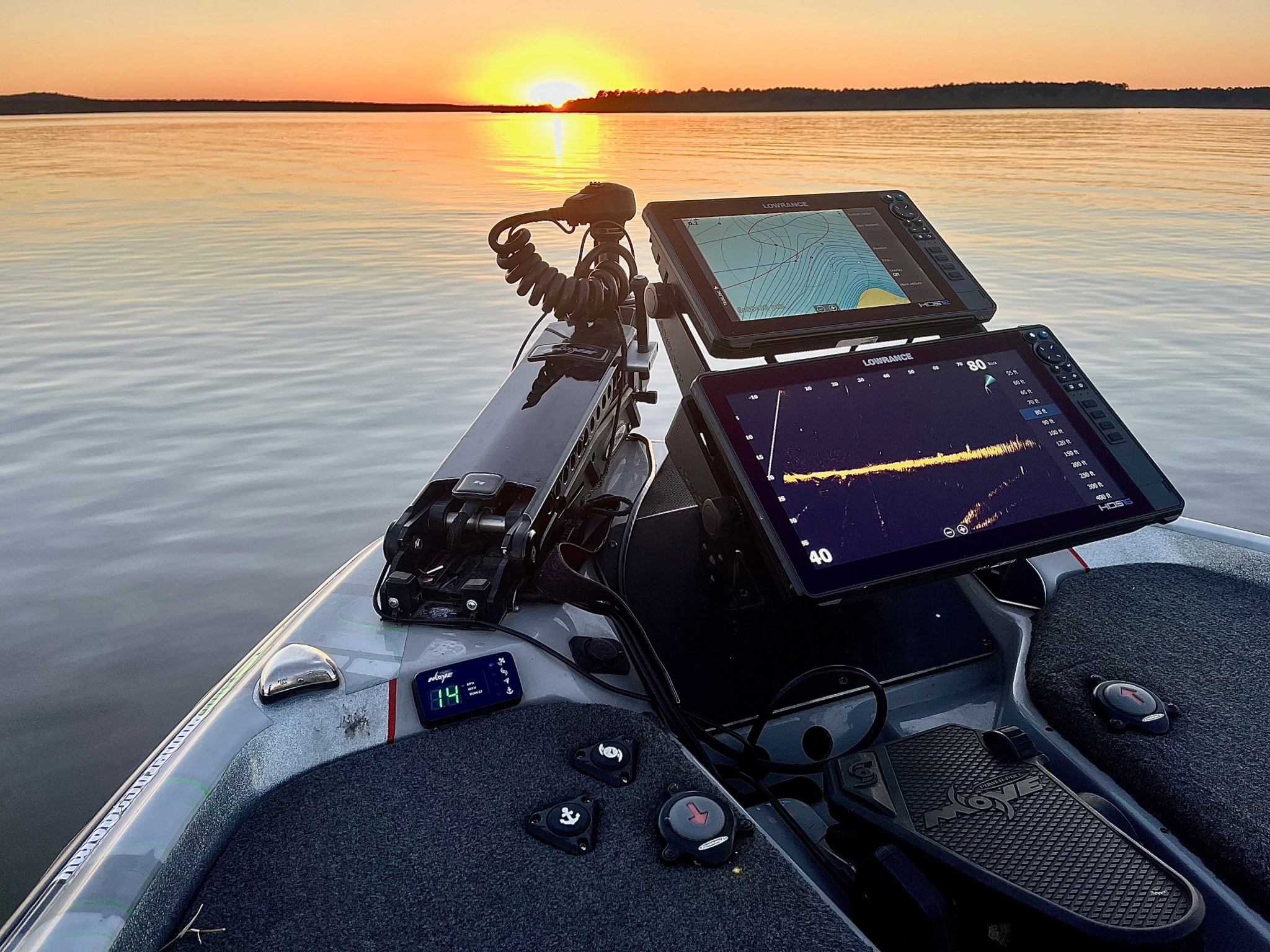We may earn revenue from the products available on this page and participate in affiliate programs. Learn More ›
The best trolling motors today compare to those of a generation ago like a modern sports car compare to the horse-drawn carriage. In fact, the distinction may be even greater, as you wouldn’t want to use your six-figure sports car to plow through a field of hydrilla or bang off cypress stumps deep in a swamp.
Sure, the earliest electric motors were a revelation, and the addition of a foot control or remote control meant that anglers had their hands free to cast, land fish, or otherwise be productive. Today’s versions, however, do so much more: They’ll follow a defined path, hold you in place against a strong wind or current, and perhaps most importantly they’re more powerful and long-lasting than ever before.
Trolling Motor Comparison
| Motor | Price | Pounds of Thrust | Volts | Shaft Lengths | Built-In Transducer | Spot Lock | Saltwater Rated |
| Minn Kota Ultrex Quest | $3,700 – $4,100 | 80, 112, 115 | 24, 36 | 45”, 52”, 60” | Yes | Yes | No |
| Garmin Force Pro | $4,000 – $4,100 | 80, 100 | 24, 36 | 50″, 57″ | Yes | Yes | Yes |
| Lowrance Ghost | $3,500, $3,750 | 97, 120 | 24, 36 | 47″, 52″, 60″ | Yes | Yes | No |
| Minn Kota Riptide Instinct Quest | $4,100 to $6,100 | 90, 115 | 24, 36 | 60″, 72″, 87″, 100″ | No | Yes | Yes |
| Power Pole Move ZR | $5,000 – $5,600 | 78, 100 | 24, 36 | 45”, 52”, 60” | Yes | Yes | Yes |
| Newport Vessels NV Series | $170 – $360 | 36, 46, 55, 62, 86 | 12, 24 | 30″, 36″ | No | No | Yes |
The Best Trolling Motors: Reviews and Recommendations
Best for Forward Facing Sonar: Minn Kota Ultrex Quest
Minn Kota
Buy It From Bass Pro
Buy it from amazon
Pros
- Exceptionally smooth and precise turning
- Brushless build makes it quiet
- Both 24 and 36 volt models make it available to boats of varying sizes and budgets
Cons
- Some anglers may find the pedal to have less functionality than the competition
Specs
- 24V (80 lb.), 36V (112 lb.), and 24/36V (90/115 lb.) thrust models
- 45”, 52”, and 60” shafts
Features
- Available with Dual Spectrum CHIRP or MEGA Side/Down Imaging
- Spot-Lock built-in
- Brushless motor
- Digital battery maximizer
The earlier versions of the Ultrex were exceptional and game-changing motors. Indeed, I’ve had at least one in my possession since 2018, across multiple boats, because they were the earliest Spot-Lock motor and have so far proven to be mostly bulletproof. With the introduction of the Quest models, however, Minn Kota upped their game. In talking to several pro anglers who rely heavily on forward-facing sonar, they elected to stay with Minn Kota even though another brand might’ve been easier to integrate with their electronics. Why? Because the steering is so easy and exceptionally precise. That means when you lock in on a fish at 100 feet, you can stay locked, rather than have to search for him again. In turn, that means you can focus on what you’re doing with your lure and what’s going on around you rather than frantically scanning side to side to relocate your quarry. The Quest is still exceptional for flying through grass, and the 24-/36-volt model allows you to configure and use batteries in the most efficient way possible to meet your needs.
Best for Tech-Obsessed Anglers: Garmin Force Pro

Garmin
Buy it from bass pro
Buy it from Garmin
Pros
- Extremely feature-rich, efficient and powerful
- Wireless connection to Garmin chartplotter
- Brushless design is stealthy
Cons
- Fewer shaft lengths than its main competitors
Specs
- 24V (80 lbs.) or 36V (100 lbs.)
- 50” and 57” shafts
Features
- Lighted directional indicator
- Reverse thrust
Garmin’s electronics have set the standard with the move into the forward-facing sonar era, and even many pros sponsored by other companies shell out their hard-earned cash to surreptitiously run them on their boats. That sometimes leads to their matching trolling motors getting overlooked, perhaps because they’re not a legacy brand in the fishing industry. That’s a mistake, because the same non-buggy performance combined with feature-rich products make their trolling motors a great choice. The new Force Pro took a great product and made it even better and more innovative. The refined Anchor Lock is an improvement on something that was already exceptional, and the coolest thing about this is that they’ve added reverse thrust capability – now you don’t need to spin the motor around to go backward, which means less strain on you and your electric motor. It also has Garmin’s GT56UHD transducer built-in, a do-it-all model that enhances the clarity of your electronics, and/or you can add an optional LiveScope transducer. Perhaps most importantly, though, it’s quiet, powerful, and cuts through grass like a knife through hot butter. Garmin is so much more than just marine products, but when they’ve entered our space, it’s been with purpose and excellence, and they continue to set a high bar.
Best Trolling Motor for Sheer Power: Lowrance Ghost

Lowrance
buy it from bass pro
Buy it from Amazon
Pros
- Amazing thrust and run time
- Configurable foot pedal
- Unique “fly-by-wire” steering
Cons
- Some anglers think the design is visually unappealing
Specs
- 24V/36V operation
- 97 lbs. or 120 lbs.
- 47”, 52” or 60” shafts
Features
- Freshwater use only
- 360-degree breakaway
Like Garmin, Lowrance is best known as an electronics company and a recent entrant into the trolling motor wars. Unlike Garmin, however, they have decades of presence on the bass tournament scene and have always been one of the default electronics choices. Pros and weekend anglers alike feel comfortable pulling the trigger on a Lowrance product, and they should. What I’ve been most amazed by is how fast the Lowrance trolling motors pull even heavy bass boats, whether it’s against current or through grass. I rode with one pro as he practiced for a sight fishing tournament, and at the end of the day the thing was still hauling the mail on a 100 percent setting, with no signs of slowing down. That’s critical if you run hard all day. I also liked the fact that Lowrance’s foot pedal is configurable – if you want the button on one side or the other, you can make that happen. If there are certain features you want readily accessible, programming the shortcut keys is a snap. There’s also an integrated battery level indicator, but no matter what it said the motor seemed to keep on churning water.
Best for Bigger Boats: Minn Kota Riptide Instinct Quest

Minn Kota
Buy it from Amazon
Pros
- Saltwater-ready
- Shafts up to 100” for big boats
- Automatically stows and deploys
Specs
- 24/36 V (90 or 115 lb.)
- 60”, 72”, 87” and 100” shafts
Features
- White or black
- Wireless remote
From muskies on St. Clair to tarpon in the Florida Keys, the Riptide is the premier choice for anglers who need greater shaft lengths to deal with high sides and occasional big waves. For guides in particular, it’s a lifesaver because the wireless remote control is both easy to use and quite responsive, meaning that they can run the One Boat Network from anywhere in the boat. That frees them to rig lines, land fish, and stay out of the way when necessary, without any loss of function. They’ve reinforced the bracket to take a beating and the motor will stow and deploy automatically with the push of a button, which takes the strain off of the angler, too.
Best for Durability: Power Pole Move ZR

Power Pole
Buy It from Bass Pro
Pros
- Sleek and lightweight
- Brushless
- Exceptionally quiet
Cons
- Significantly more expensive than its competitors
Specs
- 24/36V operations
- 78 or 100 pounds of thrust
- 45”, 52” and 60” shafts
Features
- Sonar-ready
- Easy lift deployment
Anglers traded rumors about the coming Power Pole trolling motor for years, excited that they’d potentially have access to another product from the company that had set an industry standard for durability and customer service. Not surprisingly, the reports over the first few years have been nothing short of raving. Like their signature shallow water anchors, Power Pole over-engineered this troller, while somehow making it both exceptionally sleek and lightweight. That means your boat will perform better at speed, and you can bang it into hard objects without fearing damage. That’s because they build backup systems on top of backup systems, including an aerospace grade titanium shaft. Many of the earliest testers, in both freshwater and saltwater, were in Florida, where shallow water is the name of the game and hitting obstacles is part of the bargain. What I’ve particularly noticed about these motors is that they stay super quiet even after being jostled around in rough water and banged into everything from rock piles to laydowns.

Newport Vessels NV Series
Buy It on Amazon
Pros
- Excellent for small boats and Jon boats
- Easy to install
- Available in a variety of sizes
Specs
-
Pounds of Thrust:
36, 46, 55, 62, and 86 -
Volts:
12 (36-62 lbs) and 24 (86 lb) -
Shaft Length:
30-inch (36-55 lbs) 36-inch (62 and 86 lbs) -
Price:
$170 to $360
Features
- Transom mount
- Saltwater rated
- LED battery meter
- Fiberglass shaft
Anglers powering a small skiff, jon boat, flat transom canoe or kayak need a transom mount trolling motor with a tiller drive. Newport Vessels NV trolling motor provides reliable power at a great price. Available with a 30 or 36-inch shaft and power from 33 to 86 pounds, there is an NV model to fit any small watercraft. The NV has five forward speeds and three reverse speeds with smooth transitions between settings. To monitor battery life, an LED display keeps track of the remaining power. The Newport Vessels NV is simple and inexpensive, but it is also durable with corrosion-resistant components and sturdy construction. Electric motors are lighter and safer than a small gas outboard, and the Newport Vessels NV is also less expensive and easier to operate. — Ric Burnley
Trolling Motor Accessories
Best Batteries
A a great trolling motor needs a quality battery to get full power, run all day, and keep your boat’s weight in check. Lithium batteries are powerful and light, but expensive. AGM batteries are heavy, reliable, and more affordable.
Turn a Budget Trolling Motor into a Spot-Lock Trolling Motor

GPS-enabled trolling motors are an absolute game changer for boat positioning and overall convenience. But, spot-lock trolling motors are expensive. There is a new product that will take your budget trolling motor into a remote controlled and GPS-enabled motor. The Auto Boat Smart Head costs $750 and replaces the head of your traditional trolling motor. It only takes splicing a few wires to get it operational and then you have a spot lock trolling motor for around $1,000 all in.
How to Choose the Best Trolling Motor
Shaft Length
You’ll want to keep the prop in the water at all times while fishing, so it would seem that longer would be better, but that’s not always the case. Put an 87-inch shafted motor on your bass boat or aluminum boat, and you may be able to adjust it for shallow water, but it’ll prove to be a nuisance – with the head of the motor affecting your casting and possibly preventing you from opening compartments when stowed. When in doubt, err one size up, particularly on bay boats or multi-species models, but consult with your boat manufacturer on their recommendations.
Battery Power
Batteries, from AGMs to lithiums, are more powerful and reliable than ever, but you still may only have room for two versus three. That might mitigate in favor of a 24 volt system instead of the more powerful 36. Alternatively, running on the same speed and spreading out the load over three batteries can keep you powered longer. Some of the trolling motors will now run on either 23 or 36 volts, giving the angler the option of how best to use it.
Budget
A generation ago, you could get a tournament-ready trolling motor for somewhere in the range of a grand. Now it’s possible to spend $5,000 across multiple brands. Really consider which features you need and which product best coordinates with your electronics and your boat. Although quality is generally better, more features means more things to go wrong, too. Spend your money wisely because for most of us there’s a finite budget, and what you spend on a trolling motor may cause some other component or feature to be sacrificed.
How We Tested the Best Trolling Motors
I spend plenty of time in my own bass boat, plus those of freshwater and saltwater guides around the world. Perhaps most significantly, however, I’m frequently in the boats of the top bass pros. Many, if not most, are sponsored by the trolling motor manufacturers, so except in moments of extreme weakness or frustration, they’re not likely to utter an ill word about them. On the other hand, many of them, knowing that they can get the motor quickly fixed or replaced by a service crew, treat their equipment with anything but kid gloves. They bang into things, run the motors on 100 percent for extended periods of time, slam them down into the mount, and otherwise mistreat them. Most modern trolling motors live up to their billing straight out of the box, but the true test is how they perform after a few weeks of harsh treatment.
FAQs
According to pro bass angler Chad Morgenthaler, the Garmin Force is the most powerful trolling motor. He believes that the supposed 100 pounds of thrust is a vast underrating. “I can’t prove it, but it’s way more powerful than anything else I’ve ever used. Even with my 21 foot Phoenix boat loaded heavy, with the trolling motor wide open I’ve run it as fast as 4.1 miles per hour,” he said.
12 to 16 foot boats need a 55 to 70 pound thrust trolling motor. 16 to 21 foot or longer boats need a trolling motor with 70 to 100 pound thrust.
Trolling motor speed depends on your boat design and weight. Top peed for a trolling motor can be 2 to 4 mph.
Final Thoughts on the Best Trolling Motors
Ultimately, choosing the best trolling motor is a very personal decision based on a number of factors, the two most important being the size of your boat and the size of your budget. By choosing a more powerful motor, you may also be choosing to add another battery, so factor that into the equation. Beyond those initial considerations, there may be value in buying the brand that matches your marine electronics, to ensure compatibility and to minimize interference. Just remember, while their overall reliability has increased substantially in recent years, when you add more features, you add more complications, so don’t bite off more than you can chew.
Read the full article here



